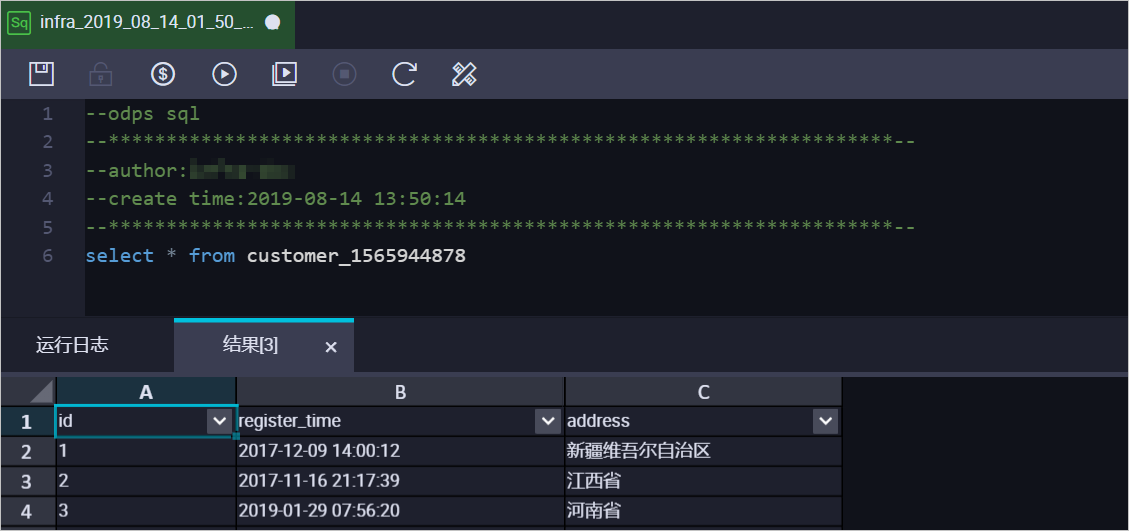本文介紹如何使用Data Transmission Service,將PolarDB-X 2.0同步至MaxCompute。
前提條件
已建立源PolarDB-X 2.0執行個體,且相容MySQL 5.7版本。更多資訊,請參見建立PolarDB-X 1.0執行個體和建立資料庫。
已開通MaxCompute。更多資訊,請參見開通MaxCompute和DataWorks。
已建立MaxCompute專案。更多資訊,請參見建立MaxCompute專案。
已設定MaxCompute白名單,允許DTS訪問MaxCompute。更多資訊,請參見設定阿里雲產品訪問MaxCompute白名單。
注意事項
DTS不會將來源資料庫中的外鍵同步到目標資料庫,因此來源資料庫的級聯、刪除等操作不會同步到目標資料庫。
類型 | 說明 |
源庫限制 |
|
其他限制 |
|
其他注意事項 | DTS會在源庫定時更新`dts_health_check`.`ha_health_check`表以推進binlog位點。 |
費用說明
| 同步類型 | 鏈路配置費用 |
| 庫表結構同步和全量資料同步 | 不收費。 |
| 增量資料同步 | 收費,詳情請參見計費概述。 |
支援同步的SQL操作
操作類型 | SQL動作陳述式 |
DML | INSERT、UPDATE、DELETE |
DDL | ALTER TABLE、ADD COLUMN 說明 不支援同步包含屬性的加列操作。 |
操作步驟
進入目標地區的同步工作清單頁面(二選一)。
通過DTS控制台進入
在左側導覽列,單擊資料同步。
在頁面左上方,選擇同步執行個體所屬地區。
通過DMS控制台進入
說明實際操作可能會因DMS的模式和布局不同,而有所差異。更多資訊,請參見極簡模式控制台和自訂DMS介面布局與樣式。
在頂部功能表列中,選擇。
在同步任務右側,選擇同步執行個體所屬地區。
單擊創建任務,進入任務配置頁面。
可選:在頁面右上方,單擊試用新版配置頁。
說明若您已進入新版配置頁(頁面右上方的按鈕為返回舊版配置頁),則無需執行此操作。
新版配置頁和舊版配置頁部分參數有差異,建議使用新版配置頁。
配置源庫及目標庫資訊。
類別
配置
說明
無
任務名稱
DTS會自動產生一個任務名稱,建議配置具有業務意義的名稱(無唯一性要求),便於後續識別。
源庫資訊
選擇已有串連資訊
您可以按實際需求,選擇是否使用已有資料庫執行個體。
如使用已有執行個體,下方資料庫資訊將自動填入,您無需重複輸入。
如不使用已有執行個體,您需要配置下方的資料庫資訊。
說明您可以在資料連線管理頁面或新版配置頁面,將資料庫錄入DTS。更多資訊,請參見資料連線管理。
DMS控制台的配置項為選擇DMS資料庫執行個體,您可以單擊新增DMS資料庫執行個體或在控制台首頁將資料庫錄入DMS。更多資訊,請參見雲資料庫錄入和他雲/自建資料庫錄入。
資料庫類型
選擇PolarDB-X 2.0。
接入方式
選擇雲執行個體。
執行個體地區
選擇PolarDB-X 2.0執行個體所屬地區。
是否跨阿里雲帳號
本樣本為同一阿里雲帳號間的同步,選擇不跨帳號。
執行個體ID
選擇源PolarDB-X 2.0執行個體ID。
資料庫帳號
填入PolarDB-X 2.0的資料庫帳號,需具備REPLICATION SLAVE、REPLICATION CLIENT及待同步對象的SELECT許可權。
說明授權方式,請參見資料同步過程中的帳號許可權問題。
資料庫密碼
填入該資料庫帳號對應的密碼。
目標庫資訊
選擇已有串連資訊
您可以按實際需求,選擇是否使用已有資料庫執行個體。
如使用已有執行個體,下方資料庫資訊將自動填入,您無需重複輸入。
如不使用已有執行個體,您需要配置下方的資料庫資訊。
說明您可以在資料連線管理頁面或新版配置頁面,將資料庫錄入DTS。更多資訊,請參見資料連線管理。
DMS控制台的配置項為選擇DMS資料庫執行個體,您可以單擊新增DMS資料庫執行個體或在控制台首頁將資料庫錄入DMS。更多資訊,請參見雲資料庫錄入和他雲/自建資料庫錄入。
資料庫類型
選擇MaxCompute。
接入方式
選擇雲執行個體。
執行個體地區
選擇目標MaxCompute執行個體所屬地區。
Project
填入MaxCompute執行個體的Project,您可以在MaxCompute工作空間列表頁面中查詢。
主帳號AccessKeyId
填入用於標識主帳號的AccessKey Id,擷取方式請參見建立AccessKey。
主帳號AccessKeySecret
填入用於驗證主帳號的密鑰AccessKey Secret,擷取方式請參見建立AccessKey。
配置完成後,單擊頁面下方的測試連接以進行下一步。
如果源或目標資料庫是阿里雲資料庫執行個體(例如RDS MySQL、ApsaraDB for MongoDB等),DTS會自動將對應地區DTS服務的IP地址添加到阿里雲資料庫執行個體的白名單中;如果源或目標資料庫是ECS上的自建資料庫,DTS會自動將對應地區DTS服務的IP地址添加到ECS的安全規則中,您還需確保自建資料庫沒有限制ECS的訪問(若資料庫是叢集部署在多個ECS執行個體,您需要手動將DTS服務對應地區的IP地址添加到其餘每個ECS的安全規則中);如果源或目標資料庫是IDC自建資料庫或其他雲資料庫,則需要您手動添加對應地區DTS服務的IP地址,以允許來自DTS伺服器的訪問。DTS服務的IP地址,請參見DTS伺服器的IP位址區段。
警告DTS自動添加或您手動添加DTS服務的公網IP位址區段可能會存在安全風險,一旦使用本產品代表您已理解和確認其中可能存在的安全風險,並且需要您做好基本的安全防護,包括但不限於加強帳號密碼強度防範、限制各網段開放的連接埠號碼、內部各API使用鑒權方式通訊、定期檢查並限制不需要的網段,或者使用通過內網(專線/VPN網關/智能網關)的方式接入。
單擊確定,完成ODPS帳號授權。
配置任務對象。
在對象配置頁面,配置待同步的對象。
配置
說明
同步類型
固定選中增量同步處理。預設情況下,您還需要同時選中庫表結構同步和全量同步。預檢查完成後,DTS會將源執行個體中待同步對象的全量資料在目的地組群中初始化,作為後續增量同步處理資料的基準資料。
目標已存在表的處理模式
預檢查並報錯攔截:檢查目標資料庫中是否有同名的表。如果目標資料庫中沒有同名的表,則通過該檢查專案;如果目標資料庫中有同名的表,則在預檢查階段提示錯誤,資料同步任務不會被啟動。
說明如果目標庫中同名的表不方便刪除或重新命名,您可以更改該表在目標庫中的名稱,請參見庫表列名映射。
忽略報錯並繼續執行:跳過目標資料庫中是否有同名表的檢查項。
警告選擇為忽略報錯並繼續執行,可能導致資料不一致,給業務帶來風險,例如:
表結構一致的情況下,如在目標庫遇到與源庫主鍵或唯一鍵的值相同的記錄:
全量期間,DTS會保留目的地組群中的該條記錄,即源庫中的該條記錄不會同步至目標資料庫中。
增量期間,DTS不會保留目的地組群中的該條記錄,即源庫中的該條記錄會覆蓋至目標資料庫中。
表結構不一致的情況下,可能會導致無法初始化資料、只能同步部分列的資料或同步失敗,請謹慎操作。
附加列規則
DTS在將資料同步到MaxCompute時,會在同步的目標表中添加一些附加列。如果附加列和目標表中已有的列出現名稱衝突將會導致資料同步失敗。您需要根據業務需求選擇新規則或舊規則。
警告在選擇附加列規則前,您需要評估附加列和目標表中已有的列是否會出現名稱衝突,否則可能會導致資料丟失或任務失敗。關於附加列的規則和定義說明,請參見附加列名稱和定義說明。
增量日誌表分區定義
根據業務需求,選擇分區名稱。關於分區的相關介紹請參見分區。
目標庫對象名稱大小寫策略
您可以配置目標執行個體中同步對象的庫名、表名和列名的英文大小寫策略。預設情況下選擇DTS預設策略,您也可以選擇與源庫、目標庫預設策略保持一致。更多資訊,請參見目標庫對象名稱大小寫策略。
源庫對象
在源庫對象框中單擊待同步對象,然後單擊
 將其移動至已選擇對象框。說明
將其移動至已選擇對象框。說明同步對象選擇的粒度為表。
已選擇對象
如需更改單個同步對象在目標執行個體中的名稱,請右擊已選擇對象中的同步對象,設定方式,請參見庫表列名單個映射。
如需批量更改同步對象在目標執行個體中的名稱,請單擊已選擇對象方框右上方的大量編輯,設定方式,請參見庫表列名批量映射。
說明如需按庫或表層級選擇同步的SQL操作,請在已選擇對象中右擊待同步對象,並在彈出的對話方塊中選擇所需同步的SQL操作。
如需設定WHERE條件過濾資料,請在已選擇對象中右擊待同步的表,在彈出的對話方塊中設定過濾條件。設定方法請參見通過SQL條件過濾任務資料。
單擊下一步高級配置,進行進階參數配置。
配置
說明
選擇調度該任務的專屬叢集
DTS預設將任務調度到共用叢集上,您無需選擇。若您希望任務更加穩定,可以購買專屬叢集來運行DTS同步任務。更多資訊,請參見什麼是DTS專屬叢集。
源庫、目標庫無法串連後的重試時間
在同步任務啟動後,若源庫或目標庫串連失敗則DTS會報錯,並會立即進行持續的重試串連,預設持續重試時間為720分鐘,您也可以在取值範圍(10~1440分鐘)內自訂重試時間,建議設定30分鐘以上。如果DTS在設定的重試時間內重新串連上源庫、目標庫,同步任務將自動回復。否則,同步任務將會失敗。
說明針對同源或者同目標的多個DTS執行個體,如DTS執行個體A和DTS執行個體B,設定網路重試時間時A設定30分鐘,B設定60分鐘,則重試時間以低的30分鐘為準。
由於串連重試期間,DTS將收取任務運行費用,建議您根據業務需要自訂重試時間,或者在源和目標庫執行個體釋放後儘快釋放DTS執行個體。
源庫、目標庫出現其他問題後的重試時間
在同步任務啟動後,若源庫或目標庫出現非串連性的其他問題(如DDL或DML執行異常),則DTS會報錯並會立即進行持續的重試操作,預設持續重試時間為10分鐘,您也可以在取值範圍(1~1440分鐘)內自訂重試時間,建議設定10分鐘以上。如果DTS在設定的重試時間內相關操作執行成功,同步任務將自動回復。否則,同步任務將會失敗。
重要源庫、目標庫出現其他問題後的重試時間的值需要小於源庫、目標庫無法串連後的重試時間的值。
是否限制全量遷移速率
在全量同步階段,DTS將佔用源庫和目標庫一定的讀寫資源,可能會導致資料庫的負載上升。您可以根據實際情況,選擇是否對全量同步任務進行限速設定(設定每秒查詢源庫的速率QPS、每秒全量遷移的行數RPS和每秒全量遷移的數據量(MB)BPS),以緩解目標庫的壓力。
說明僅當同步類型選擇了全量同步時才可以配置。
是否限制增量同步處理速率
您也可以根據實際情況,選擇是否對增量同步處理任務進行限速設定(設定每秒增量同步處理的行數RPS和每秒增量同步處理的數據量(MB)BPS),以緩解目標庫的壓力。
是否去除正反向任務的心跳錶sql
根據業務需求選擇是否在DTS執行個體運行時,在源庫中寫入心跳SQL資訊。
是:不在源庫中寫入心跳SQL資訊,DTS執行個體可能會顯示有延遲。
否:在源庫中寫入心跳SQL資訊,可能會影響源庫的物理備份和複製等功能。
環境標籤
您可以根據實際情況,選擇用於標識執行個體的環境標籤。本樣本無需選擇。
配置ETL功能
選擇是否配置ETL功能。關於ETL的更多資訊,請參見什麼是ETL。
是:配置ETL功能,並在文字框中填寫資料處理語句,詳情請參見在DTS遷移或同步任務中配置ETL。
否:不配置ETL功能。
監控警示
是否設定警示,當同步失敗或延遲超過閾值後,將通知警示連絡人。
不設定:不設定警示。
設定:設定警示,您還需要設定警示閾值和警示通知。更多資訊,請參見在配置任務過程中配置監控警示。
儲存任務並進行預檢查。
若您需要查看調用API介面配置該執行個體時的參數資訊,請將滑鼠游標移動至下一步儲存任務並預檢查按鈕上,然後單擊氣泡中的預覽OpenAPI參數。
若您無需查看或已完成查看API參數,請單擊頁面下方的下一步儲存任務並預檢查。
說明在同步作業正式啟動之前,會先進行預檢查。只有預檢查通過後,才能成功啟動同步作業。
如果預檢查失敗,請單擊失敗檢查項後的查看詳情,並根據提示修複後重新進行預檢查。
如果預檢查產生警告:
對於不可以忽略的檢查項,請單擊失敗檢查項後的查看詳情,並根據提示修複後重新進行預檢查。
對於可以忽略無需修複的檢查項,您可以依次單擊點擊確認警示詳情、確認屏蔽、確定、重新進行預檢查,跳過警示檢查項重新進行預檢查。如果選擇屏蔽警示檢查項,可能會導致資料不一致等問題,給業務帶來風險。
購買執行個體。
預檢查通過率顯示為100%時,單擊下一步購買。
在購買頁面,選擇資料同步執行個體的計費方式、鏈路規格,詳細說明請參見下表。
類別
參數
說明
資訊配置
計費方式
預付費(訂用帳戶):在建立執行個體時支付費用。適合長期需求,價格比隨用隨付更實惠,且購買時間長度越長,折扣越多。
後付費(隨用隨付):按小時計費。適合短期需求,用完可立即釋放執行個體,節省費用。
資源群組配置
執行個體所屬的資源群組,預設為default resource group。更多資訊,請參見什麼是資源管理。
鏈路規格
DTS為您提供了不同效能的同步規格,同步鏈路規格的不同會影響同步速率,您可以根據業務情境進行選擇。更多資訊,請參見資料同步鏈路規格說明。
訂購時間長度
在預付費模式下,選擇訂用帳戶執行個體的時間長度和數量,包月可選擇1~9個月,包年可選擇1年、2年、3年和5年。
說明該選項僅在付費類型為預付費時出現。
配置完成後,閱讀並勾選《資料轉送(隨用隨付)服務條款》。
單擊購買並啟動,並在彈出的確認對話方塊,單擊確定。
您可在資料同步介面查看具體任務進度。
增量日誌表結構定義說明
你需要在MaxCompute中執行set odps.sql.allow.fullscan=true;,設定專案空間屬性,允許進行全表掃描。
DTS在將MySQL產生的增量資料同步至MaxCompute的增量日誌表時,除了儲存增量資料,還會儲存一些元資訊,樣本如下。

樣本中的modifytime_year、modifytime_month、modifytime_day、modifytime_hour、modifytime_minute為分區欄位,是在配置任務對象步驟中指定的。
結構定義說明
欄位 | 說明 |
record_id | 增量日誌的記錄ID,為該日誌唯一標識。 說明
|
operation_flag | 操作類型,取值:
|
utc_timestamp | 操作時間戳記,即binlog的時間戳記(UTC 時間)。 |
before_flag | 所有列的值是否為更新前的值,取值:Y或N。 |
after_flag | 所有列的值是否為更新後的值,取值:Y或N。 |
關於before_flag和after_flag的補充說明
對於不同的操作類型,增量日誌中的before_flag和after_flag定義如下:
INSERT
當操作類型為INSERT時,所有列的值為新插入的記錄值,即為更新後的值,所以before_flag取值為N,after_flag取值為Y,樣本如下。

UPDATE
當操作類型為UPDATE時,DTS會將UPDATE操作拆為兩條增量日誌。這兩條增量日誌的record_id、operation_flag及utc_timestamp對應的值相同。
第一條增量日誌記錄了更新前的值,所以before_flag取值為Y,after_flag取值為N。第二條增量日誌記錄了更新後的值,所以before_flag取值為N,after_flag取值為Y,樣本如下。

DELETE
當操作類型為DELETE時,增量日誌中所有的列值為被刪除的值,即列值不變,所以before_flag取值為Y,after_flag取值為N,樣本如下。

全量資料合併樣本
執行資料同步的操作後,DTS會在MaxCompute中分別建立該表的全量基準表和增量日誌表。您可以通過MaxCompute的SQL命令,對這兩個表執行合併作業,得到某個時間點的全量資料。
本案例以customer表為例(表結構如下),介紹操作流程。

根據源庫中待同步表的結構,在MaxCompute中建立用於儲存合并結果的表。
例如,需要擷取customer表在
1565944878時間點的全量資料。為方便業務識別,建立如下資料表:CREATE TABLE `customer_1565944878` ( `id` bigint NULL, `register_time` datetime NULL, `address` string);說明您可以在MaxCompute的臨時查詢中,運行SQL命令。
關於MaxCompute支援的資料類型與相關說明,請參見資料類型。
在MaxCompute中執行如下SQL命令,合并全量基準表和增量日誌表,擷取該表在某一時間點的全量資料。
set odps.sql.allow.fullscan=true; insert overwrite table <result_storage_table> select <col1>, <col2>, <colN> from( select row_number() over(partition by t.<primary_key_column> order by record_id desc, after_flag desc) as row_number, record_id, operation_flag, after_flag, <col1>, <col2>, <colN> from( select incr.record_id, incr.operation_flag, incr.after_flag, incr.<col1>, incr.<col2>,incr.<colN> from <table_log> incr where utc_timestamp< <timestamp> union all select 0 as record_id, 'I' as operation_flag, 'Y' as after_flag, base.<col1>, base.<col2>,base.<colN> from <table_base> base) t) gt where row_number=1 and after_flag='Y'說明<result_storage_table>:儲存全量merge結果集的表名。
<col1>/<col2>/<colN>:同步表中的列名。
<primary_key_column>:同步表中的主鍵列名。
<table_log>:增量日誌表名。
<table_base>:全量基準表名。
<timestamp>:需要擷取全量資料的時間點。
合并資料表,擷取customer表在
1565944878時間點的全量資料,樣本如下:set odps.sql.allow.fullscan=true; insert overwrite table customer_1565944878 select id, register_time, address from( select row_number() over(partition by t.id order by record_id desc, after_flag desc) as row_number, record_id, operation_flag, after_flag, id, register_time, address from( select incr.record_id, incr.operation_flag, incr.after_flag, incr.id, incr.register_time, incr.address from customer_log incr where utc_timestamp< 1565944878 union all select 0 as record_id, 'I' as operation_flag, 'Y' as after_flag, base.id, base.register_time, base.address from customer_base base) t) gt where gt.row_number= 1 and gt.after_flag= 'Y';上述命令執行完成後,可在customer_1565944878表中查詢合并後的資料。
